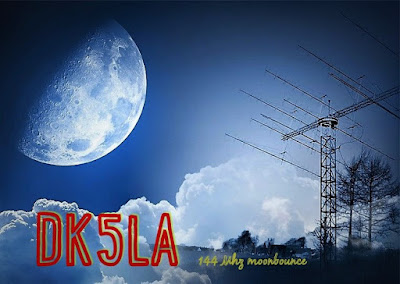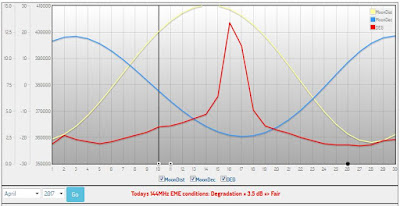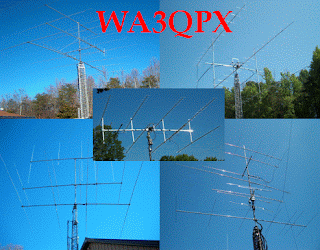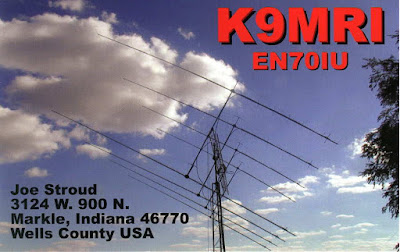Posts Tagged ‘EME’
 May’s ‘Red Ryder’ EME Ops
May’s ‘Red Ryder’ EME Ops
There still seems to be a number of 'big guns' showing up each month, that I have not heard or worked before as well as several 2-Yagi 'little pistols' that I am able to work under very good lunar path conditions. I suspect that having just 1-Yagi puts me in the $2.95 'Red Ryder' category!

With the QSL's from last month's surprisingly good EME conditions just starting to arrive, May's moonbounce operation continued to produce good results.
Whether this is because of better than normal lunar path conditions or just a result of my neighbour's tree-pruning, remains to be seen.
The few days of operating in early May were, as usual, planned to take advantage of the Moon's closest approach as well as the Moon's most northerly declinations. The latter condition puts moonrises directly out in front of the house and looking across Georgia Strait's many miles of saltwater. The extra theoretical 'sea-gain' appears to be a reality under these conditions and allows my 9el Yagi to garner another 6db on both transmit and receive paths, making it perform more like a '4-Yagi' array.
Eight stations were worked this time around, with six of them being new 'initials', bringing my EME total from 95 to 101. Several of these stations were speaker-audible, at CW levels.
NTØV #96
IK7EZN #97
EA2AGZ #98
G4SWX
F6HVK #99
G4CDN #100
DK5LA #101
DK3BU
For now, any earlier thoughts of building a 4CX250 300 watt amplifier have been put on hold, while I continue to slowly work my way through what seems a never-ending list of workable stations.

With the QSL's from last month's surprisingly good EME conditions just starting to arrive, May's moonbounce operation continued to produce good results.
Whether this is because of better than normal lunar path conditions or just a result of my neighbour's tree-pruning, remains to be seen.
The few days of operating in early May were, as usual, planned to take advantage of the Moon's closest approach as well as the Moon's most northerly declinations. The latter condition puts moonrises directly out in front of the house and looking across Georgia Strait's many miles of saltwater. The extra theoretical 'sea-gain' appears to be a reality under these conditions and allows my 9el Yagi to garner another 6db on both transmit and receive paths, making it perform more like a '4-Yagi' array.
Eight stations were worked this time around, with six of them being new 'initials', bringing my EME total from 95 to 101. Several of these stations were speaker-audible, at CW levels.
NTØV #96
IK7EZN #97
EA2AGZ #98
G4SWX
F6HVK #99
G4CDN #100
DK5LA #101
DK3BU
 | ||||
| IK7EZN's cross polarized 4 x 13 array |
 |
| EA2AGZ's 4 x 16 array |
 |
| DK5LA's cross polarized 8 x 16 array ...very loud! |
For now, any earlier thoughts of building a 4CX250 300 watt amplifier have been put on hold, while I continue to slowly work my way through what seems a never-ending list of workable stations.
 April Moonbounce
April Moonbounce
 |
| My Moonrise |
This week I had several days of unobstructed ocean moonrises as the Moon peaked on its monthly northern declination track. Thanks to the recent topping of my next door neighbour's large Douglas Fir, and removal of low-hanging branches, I am now able to track moonrises a little further to the south than before and can add two more EME days that were previously blocked by the large tree. All operations are on 2m JT65B mode, using a 9el Yagi and 140W output.
When I started (April 1) conditions looked as if they should be good, with lunar perigee (Moon's closest approach), degradation (background skynoise) and declination all looking favorable, but I was in for a surprise.
The rising yellow plot indicates the Earth-Moon distance growing further apart (increasing path losses) while the red plot indicates fluctuation in daily skynoise (temperature) near the moon. The blue plot indicates declination track from north to south ... for me, the higher the better.
 |
| courtesy: http://www.mmmonvhf.de/eme.php |
On day three, five new 'initials' were worked including one new state (New York) and two new DXCC countries! Truly surprising was that two of the stations worked were using just two Yagis, with both stations answering one of my 'CQ's.
Good conditions continued for the next few days, bringing my initials count from #87 to # 95, with the following stations all going into the log, turning a disappointing start into one of the best lunar sessions I have encountered:
HA6NQ, LZ2FO (two 13 el Yagis), EB5EEO, K2ZJ (two 14 el Yagis), DK5YA, S52LM, F8DO, PA5Y, SV6KRW, UA3PTW, OK1UGA.
April's operation brought my 2m DXCC count to 29 and states worked total to 27.
| SV6KRW's 4 x 8el Array |
| EB5EEO's 4 x 32el Cross-polarized Array (16V / 16H) |
 |
| DK5YA's 4 x 22 Cross-polarized Array (11V / 11H) |
 April Moonbounce
April Moonbounce
 |
| My Moonrise |
This week I had several days of unobstructed ocean moonrises as the Moon peaked on its monthly northern declination track. Thanks to the recent topping of my next door neighbour's large Douglas Fir, and removal of low-hanging branches, I am now able to track moonrises a little further to the south than before and can add two more EME days that were previously blocked by the large tree. All operations are on 2m JT65B mode, using a 9el Yagi and 140W output.
When I started (April 1) conditions looked as if they should be good, with lunar perigee (Moon's closest approach), degradation (background skynoise) and declination all looking favorable, but I was in for a surprise.
The rising yellow plot indicates the Earth-Moon distance growing further apart (increasing path losses) while the red plot indicates fluctuation in daily skynoise (temperature) near the moon. The blue plot indicates declination track from north to south ... for me, the higher the better.
 |
| courtesy: http://www.mmmonvhf.de/eme.php |
On day three, five new 'initials' were worked including one new state (New York) and two new DXCC countries! Truly surprising was that two of the stations worked were using just two Yagis, with both stations answering one of my 'CQ's.
Good conditions continued for the next few days, bringing my initials count from #87 to # 95, with the following stations all going into the log, turning a disappointing start into one of the best lunar sessions I have encountered:
HA6NQ, LZ2FO (two 13 el Yagis), EB5EEO, K2ZJ (two 14 el Yagis), DK5YA, S52LM, F8DO, PA5Y, SV6KRW, UA3PTW, OK1UGA.
April's operation brought my 2m DXCC count to 29 and states worked total to 27.
| SV6KRW's 4 x 8el Array |
| EB5EEO's 4 x 32el Cross-polarized Array (16V / 16H) |
 |
| DK5YA's 4 x 22 Cross-polarized Array (11V / 11H) |
 March Moonbounce
March Moonbounce
Tied up with other radio happenings, I missed getting on EME during the moon's last two orbits of the planet. I was able to get back at it last week, with three days of unobstructed ocean moonrises as the moon travelled through its northern declination peak.
Conditions seemed unusually good and I was able to complete several contacts with my small station ... a single 9el m2 Yagi and an older 2m 140W brick amplifier. The Yagi is nestled atop my 50' tower's mast, between my triband Yagi, and Yagis for 6m and 70cm. The tower is located about 100' from the ocean and on these favorable moonrises, looks towards the moon directly over saltwater. The antenna appears to develop the full 'theoretical' 6db of seagain and performance seems fairly similar to what I would expect from a box of four similar Yagis.
Stations worked last week (all on JT65B) where: I3MEK, WA3QPX, G4DML, EA5SR, SP8NR, PA0JMV and K9MRI. The first three stations had been previously worked but answered my CQ while the remainder where all new, representing 'initials' #84 - #87 using this simple system.
 | |
| WA3QPX 4 X 28 el Yagi array |
 |
| EA8SR's 4 X 9el Yagi array |
| G4DML's 4 X 8el Yagi array |
 |
| K9MRI's monster array - 8 x 28el Yagis |
K9MRI provided the best signal report I had ever received on moonbounce, a -15db and indicated that my signal was audible during our QSO!
WA3QPX represented a new 2m state, which made me wonder what my confirmed state totals had reached ... 26 now, including EME and terrestrial contacts. Interestingly, my 2m DXCC total also stands at this same number ... 26 confirmed.
With such a low ERP, I often think that I will eventually run out of stations that I can work on EME, yet I continue to see many new stations every time I get on the air ... likely enough to keep me challenged for some time yet.
I often hear stations better than they are hearing me so if I do run out of stations, the next logical step would be a modest 3db increase in my power by building a simple 300W amplifier. An extra 3db would probably open up a large number of new challenging target stations to work with.
I have a box of NIB 4CX250Bs and sockets that have been looking at me longingly for some time!
 March Moonbounce
March Moonbounce
Tied up with other radio happenings, I missed getting on EME during the moon's last two orbits of the planet. I was able to get back at it last week, with three days of unobstructed ocean moonrises as the moon travelled through its northern declination peak.
Conditions seemed unusually good and I was able to complete several contacts with my small station ... a single 9el m2 Yagi and an older 2m 140W brick amplifier. The Yagi is nestled atop my 50' tower's mast, between my triband Yagi, and Yagis for 6m and 70cm. The tower is located about 100' from the ocean and on these favorable moonrises, looks towards the moon directly over saltwater. The antenna appears to develop the full 'theoretical' 6db of seagain and performance seems fairly similar to what I would expect from a box of four similar Yagis.
Stations worked last week (all on JT65B) where: I3MEK, K9MRI, PA0JMV, WA3QPX, G4DML, EA5SR, and SP8NR. The first three stations had been previously worked but answered my CQ while the remainder where all new, representing 'initials' #84 - #87 using this simple system.
 | |
| WA3QPX 4 X 28 el Yagi array |
 |
| EA8SR's 4 X 9el Yagi array |
| G4DML's 4 X 8el Yagi array |
 |
| K9MRI's monster array - 8 x 28el Yagis |
K9MRI provided the best signal report I had ever received on moonbounce, a -15db and indicated that my signal was audible during our QSO!
WA3QPX represented a new 2m state, which made me wonder what my confirmed state totals had reached ... 26 now, including EME and terrestrial contacts. Interestingly, my 2m DXCC total also stands at this same number ... 26 confirmed.
With such a low ERP, I often think that I will eventually run out of stations that I can work on EME, yet I continue to see many new stations every time I get on the air ... likely enough to keep me challenged for some time yet.
I often hear stations better than they are hearing me so if I do run out of stations, the next logical step would be a modest 3db increase in my power by building a simple 300W amplifier. An extra 3db would probably open up a large number of new challenging target stations to work with.
I have a box of NIB 4CX250Bs and sockets that have been looking at me longingly for some time!
 EME In The ’80s
EME In The ’80s
 |
| VE7SL - my original 2m EME antenna. |
Unlike today's widespread JT65B usage on eme, where signals can be many db into the noise and inaudible by ear, eme contacts could only be completed by actually copying signals that you could hear with your ears. This usually required big antennas and lots of power.
After a year and a half of evening work in my basement shop, my system was pretty much ready to go. I built a kilowatt amplifier, from the ARRL's VHF Handbook, along with its plate and screen power supplies.
 |
| 2m 'Plumbers Delight' handbook amp. |
My antennas (see above), as well as the large H-frame support, were also built in the basement and used all scrap aluminum from one of the numerous scrap yards that were in Vancouver at the time. The system consisted of sixteen separate 6 element NBS-styled yagis, all phased. Many of the two-dozen plus N connectors were bought at Boeing Surplus near Seattle, another interesting source of parts, also now long gone. Keeping water out of the phasing lines and connectors was a real challenge here in the rain forest and if one connector was not done exactly right, would create a lot of headaches.
The antenna took up a large portion of my small, 33'-wide suburban backyard. Pointing was all done by hand, using homemade scales to indicate elevation and azimuth angles, so that it could be pointed accurately even on cloud covered days and nights. A hand-cranked boat winch took care of elevation. I had a switch-box full of surplus VHF relays out at the antenna that protected my JFET preamp and also allowed me to compare sky and sun noise against a 50 ohm load.
Over the course of a few years, the system was employed to work many Europeans as well as North American VEs' and Ws'. The one contact that stands out memorable for me, was with UA3TCF, east of Moscow. This was because I had to aim the array directly into my two-story house, located about 20' away! The moon was very low as well, so that not much elevation was required.
I eventually found that trying to hold down a full-time high school teaching job and running sked requests at 0300 were not very compatible! It also became a lot of work just to maintain the system properly. I had met and completed my original goals and it became time to move on.
Eventually the array was broken down into smaller sections and sold to local 2m guys, along with the amplifier ... but it was a huge learning experience for me and the fact that I survived building and playing with a 2,000 volt power supply, still scares the heck out of me!
 |
| Plate & screen supply for the 2m amp. |
 |
| The VHF rack with xvrtrs and amps 50mHz-432mHz. |
 |
| My gal Sal adorning the 2m tower on a snowy Sunday morning. |
 EME In The ’80s
EME In The ’80s
 |
| VE7SL - my original 2m EME antenna. |
Unlike today's widespread JT65B usage on eme, where signals can be many db into the noise and inaudible by ear, eme contacts could only be completed by actually copying signals that you could hear with your ears. This usually required big antennas and lots of power.
After a year and a half of evening work in my basement shop, my system was pretty much ready to go. I built a kilowatt amplifier, from the ARRL's VHF Handbook, along with its plate and screen power supplies.
 |
| 2m 'Plumbers Delight' handbook amp. |
My antennas (see above), as well as the large H-frame support, were also built in the basement and used all scrap aluminum from one of the numerous scrap yards that were in Vancouver at the time. The system consisted of sixteen separate 6 element NBS-styled yagis, all phased. Many of the two-dozen plus N connectors were bought at Boeing Surplus near Seattle, another interesting source of parts, also now long gone. Keeping water out of the phasing lines and connectors was a real challenge here in the rain forest and if one connector was not done exactly right, would create a lot of headaches.
The antenna took up a large portion of my small, 33'-wide suburban backyard. Pointing was all done by hand, using homemade scales to indicate elevation and azimuth angles, so that it could be pointed accurately even on cloud covered days and nights. A hand-cranked boat winch took care of elevation. I had a switch-box full of surplus VHF relays out at the antenna that protected my JFET preamp and also allowed me to compare sky and sun noise against a 50 ohm load.
Over the course of a few years, the system was employed to work many Europeans as well as North American VEs' and Ws'. The one contact that stands out memorable for me, was with UA3TCF, east of Moscow. This was because I had to aim the array directly into my two-story house, located about 20' away! The moon was very low as well, so that not much elevation was required.
I eventually found that trying to hold down a full-time high school teaching job and running sked requests at 0300 were not very compatible! It also became a lot of work just to maintain the system properly. I had met and completed my original goals and it became time to move on.
Eventually the array was broken down into smaller sections and sold to local 2m guys, along with the amplifier ... but it was a huge learning experience for me and the fact that I survived building and playing with a 2,000 volt power supply, still scares the heck out of me!
 |
| Plate & screen supply for the 2m amp. |
 |
| The VHF rack with xvrtrs and amps 50mHz-432mHz. |
 |
| My gal Sal adorning the 2m tower on a snowy Sunday morning. |

















